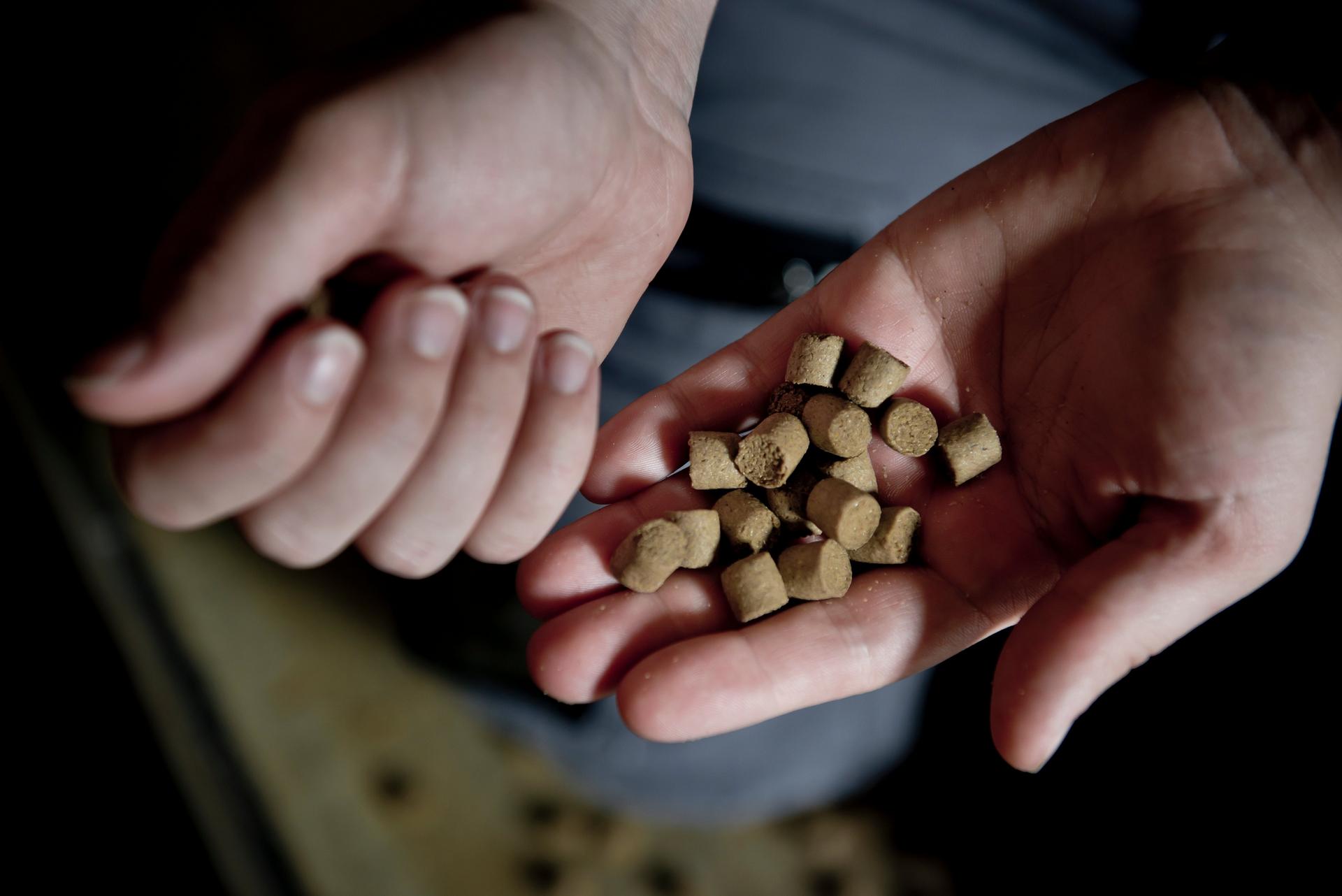- Ernæring
- Fisk og skaldyr
Bedre foder resulterer i bedre mad til os alle
Hos BioMar forstår vi, at rejsen til enestående fisk og rejer begynder længe før, den når bordet, og den starter med det foder, der giver næring til fisk og rejer.
In fish farming, being attentive to oxygen levels and implementing oxygenation are important prerequisites for maintaining economic growth rates.
Oxygen is one of the foremost important vital gasses for fish to thrive and needs to be present in farm water in appropriate quantities. A fish can regulate its oxygen requirement until the oxygen content in the water reaches a critical low point. In order to avoid suffocation of the fish during the shortage, the water must be additionally enriched with oxygen.
Oxygen measurement
Large fluctuations in the oxygen content of fish farming water have a negative impact on the well-being of the fish. In trout farming, for instance, the recommendation is to keep the oxygen level at 100 % as it enters the pond, and that the oxygen content at the outflow should still measure 70 % for the needs of the trout to be adequately met. It is beneficial to use an oxygen measuring device that will record data over an extended period. Regular or continuous measurements make it possible to identify poor environmental conditions at an early stage, allowing to take the necessary countermeasures.

Oxygenation
At sub-optimal oxygen levels, experience shows that oxygenation of the production water is necessary to achieve optimal feed conversion rates. It is rarely a feasible option to use an additional water supply to improve the oxygen level. Therefore, it is often necessary to implement technical solutions.
Methods of oxygen enrichment
The various methods of oxygen enrichment vary in terms of how effective they are and of their impact on other gases in the water. The maximum possible oxygen saturation offered varies from 70 % with a paddle-wheel surface aerator to several hundred percent with pressure systems and liquid oxygen.

The different methods of oxygen enrichment vary in terms of how effective they are.
Introduction of liquid oxygen – example jet platform
It is worth noting that the use of liquid oxygen is the only method that can achieve an oxygen saturation of over 100 %. It is also relevant to know that the water is not "refreshed" by the enrichment with liquid oxygen but is merely saturated with oxygen. All degassing should be completed prior to oxygenation. One method of oxygen enrichment using liquid oxygen is the jet platform. In a jet platform, water passes from a distribution chamber through a horizontal plate with specially designed nozzles, creating water jets. The jets travel through a chamber enriched with oxygen by means of liquid oxygen.

Since, the jets hit the surface of the water surface approx. 20 cm below the plate. The jets blow oxygen bubbles down into the water, creating a “fog of bubbles”. This ensures that the oxygen mixes well with the water, and here, in the dissolution zone, the oxygen dissolves into the water. An efficient jet platform requires a difference of height between the water surface in the distribution chamber and the water surface in the outflow of approx. 75 cm. This can often be achieved using natural gravity. If this is not possible, a relatively energy-efficient propeller pump may be installed.
Picture: Jet platform (schematic cross-section). The jet platform is a method of oxygen enrichment using liquid oxygen. The use of liquid oxygen is the only oxygenation method that can achieve an oxygen saturation of over 100 %.
Aeration columns
Aeration columns, also known as cascade aerators, are often made up of bio-blocks or perforated plates, which bring the water into contact with the air over a large surface area. The water is channelled by means of a pump or by using a natural gradient. The size of the cascade depends on the quantity of water involved. In principle, 1 bio-block serves a water quantity of approx. 12 – 15 l/sec. It is necessary for the bio-blocks to be well ventilated. And, as with all systems, cleaning must be carried out on a regular basis to avoid blockages and the overgrowth of algae.

Picture: Aeration column (schematic cross-section). An advantage of this system lies in the simultaneous partial removal of undesirable gases.
One advantage of this system lies in the simultaneous partial removal of undesirable gases such as carbon dioxide, ammonia and nitrogen, and in spring water, some of the active carbonic acid can be removed.
Airlift pump
The principle of an airlift pump is that compressed air is blown through a system consisting of perforated tubes at a depth of 70-80 cm. This system introduces oxygen from the air into the water. In many fish farms, these systems are installed as a permanent feature. It is likewise possible to use portable airlift pumps. The airlift can also increase the water circulation in the pond and lead to a partial "de-gasification" of the water.

Airlift pump, design and application
Surface aerator
Surface aerators are installed above the surface of the water. They use electrically operated "paddles/propellers" to aerate the water.
The water is refreshed through contact with the air. A maximum saturation of 70 % oxygen can be achieved with water temperatures up to approx. 15 °C. It is difficult to guarantee the necessary oxygen supply for economic feed conversion rates using a surface aerator.

BioFarm – BioMar’s Expert Advisory Team
Many years of experience, a huge number of measurements, and reports from farmers who have introduced oxygenation equipment show that the costs of buying oxygen measuring devices and the time spent on supervision as well as an immediate response to water values are worthwhile and soon covered by the increased revenues from higher growth/better feed conversion rates and an increased vitality and health status of the fish.
The cleaning and maintenance of any measuring and oxygenation equipment are important routine tasks as they ensure that the devices function correctly and economically. BioMar’s technical advisory team, BioFarm, offers support in the management of oxygen and other fish farm management topics. Feel free to contact the BioFarm team member responsible for your area for further information.
Resultater (39)
?w=1920&%24withDefaultImage%24=&fmt=auto)
Hos BioMar forstår vi, at rejsen til enestående fisk og rejer begynder længe før, den når bordet, og den starter med det foder, der giver næring til fisk og rejer.

Wheat gluten is a common ingredient in modern aquaculture diets, valued for a combination of nutritional and functional advantages. It isn’t a magic ingredient, but it consistently supports efficient feed production and healthy fish growth. One of its best-known traits is its strong binding ability earning it the occasional nickname “super glue.” This natural binding property allows many feed mills to reduce or even eliminate synthetic binders.

Slagteklare laks blev analyseret for at bestemme den spiselige del. Resultatet viste, at hele 74 procent af laksen bestod af rent fiskekød.

Specialized BioMar feeds designed for performance, resilience, and efficiency in cold-water conditions Winter brings real challenges for trout farmers. As temperatures drop, metabolism slows, appetite declines, and maintaining growth can feel like an uphill battle. BioMar’s winter feeds are developed to keep your fish progressing through the toughest months delivering reliable intake, efficient conversion, and strong resilience all winter long.

The oxygen content of the water is often the most prominent limiting factor in intensive fish farming. It is a well-known fact that poor oxygen content means that it is not possible to utilise the full potential of both the fish and the feed. A jet platform is an example of an efficient and yet simple mechanical method for oxygen enrichment of water.

Fiskeopdrættere kan opnå bedre resultater ved at bruge mindre foder

In fish farming, large fluctuations in the oxygen content of water have a negative impact on the well-being of the fish and consequently on its growth. High water temperatures or rich vegetation in the water are important alarming factors to observe, especially in summer periods.

From its nutritional profile to its traceable sourcing and regenerative potential, soy is redefining what it means to feed the future of aquaculture.

As the global demand for sustainable aquaculture practices continues to rise, so does the need for alternatives to traditional fish meal and fish oil. One of the most promising innovations in this space is AlgaPrime, a revolutionary ingredient that provides a sustainable and nutritious source of omega-3 fatty acids, particularly DHA.

Every year, billions of chickens are processed for food - leaving behind mountains of feathers. While most see this as waste, aquaculture nutritionists see something else entirely: opportunity. These feathers, once destined for landfills, are now being transformed into a high-protein, sustainable ingredient known as feather meal.

I et nyligt ørred foderforsøg med yngel beviste Inicio Plus endnu en gang sin styrke ved at opnå hurtigere vækst og mere ensartet yngel end konkurrerende startfoder. Den bedste visuelle vandkvalitet blev observeret med BioMar-foderet, hvilket afspejler dets positive indvirkning ud over vækstpræstationen.
